I am about to give you the most effective solution for smelly aquariums. It is aquarium lava rocks. They are one of the best solutions to keep the odor away from the aquarium.
Lava rocks also help with the hardscape of your aquarium. So, they are a 2 in 1 solution to keep your aquarium clean and classy.
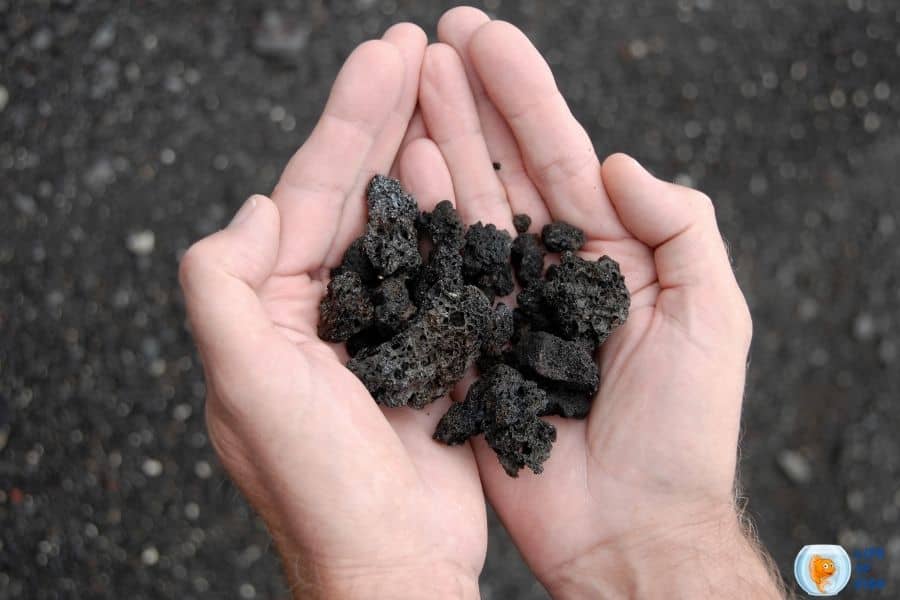
What are lava rocks?
Jump To
Aquarium lava rocks are formed due to the cooling of lava after an eruption. Lava rocks come in various shapes and sizes, but they are mostly blackish or brownish rocks.
These rock types have pores that easily trap dirt, debris, uneaten food particles, and ammonia from fish waste.
The porous surface of these rocks allows beneficial bacteria to grow on them as they are the only place in an aquarium where they have a good amount of surface area to colonize.
These bacteria help convert dangerous ammonia into nitrite and then into safe nitrates, which can be easily removed from an aquarium through water changes or gravel vacuuming.
Lava rock is also known as volcanic rocks or igneous rocks, and they are a great way to provide a natural-looking environment for your aquarium, terrarium, and landscapes.
Benefits of using lava rock in an aquarium
There are many benefits of having lava rock as part of the hardscape in your tank. Here is why you should have them-
Harbors beneficial bacteria
Lava rocks are an easy way to improve water quality.
They provide surface area for beneficial bacteria, which convert harmful ammonia into nitrate and help make your aquarium smell better.
Provides a natural environment for your fish
Lava rocks are a great way to provide your fish with the perfect environment, and they come in all different shapes and sizes.
Many prey fish are timid and like caves and crevices to hide in. Lava rocks include both hiding spots as well as places for your fish to hang out.
Prevents diseases from spread among fish
When you place your lava rock inside the aquarium, it will prevent other fishes from coming into direct contact with each other by limiting their territory boundaries and making them feel safe.
This reduces stress levels for all of your fish, preventing disease outbreaks or sudden changes that can cause stress.
Limits the effects of nitrates on algae growth
Lava rocks have a porous surface that is perfect for housing beneficial bacteria which convert harmful ammonia into nitrate.
These beneficial bacteria are great at limiting the amount of nitrate in an aquarium and can prevent excess nutrients from helping algae grow better than they usually would.
Increase aesthetic appearance
The lava rocks can be used as decoration for your aquarium.
They have a blackish color and rough-textured surface that makes them perfect for ornamental purposes.
They are relatively cheap and easy to find
Lava rocks are easy to find at most pet stores, and they come in a variety of shapes, sizes, and colors. They can be used for almost all kinds of aquariums, including ponds.
Lava rocks are pH neutral
The majority of lava rocks are inherently pH neutral, which means they will not affect the pH level in any way.
For those species who love a specific number in their tank (like 7, for instance), this can be an important consideration when hardscaping your aquarium.
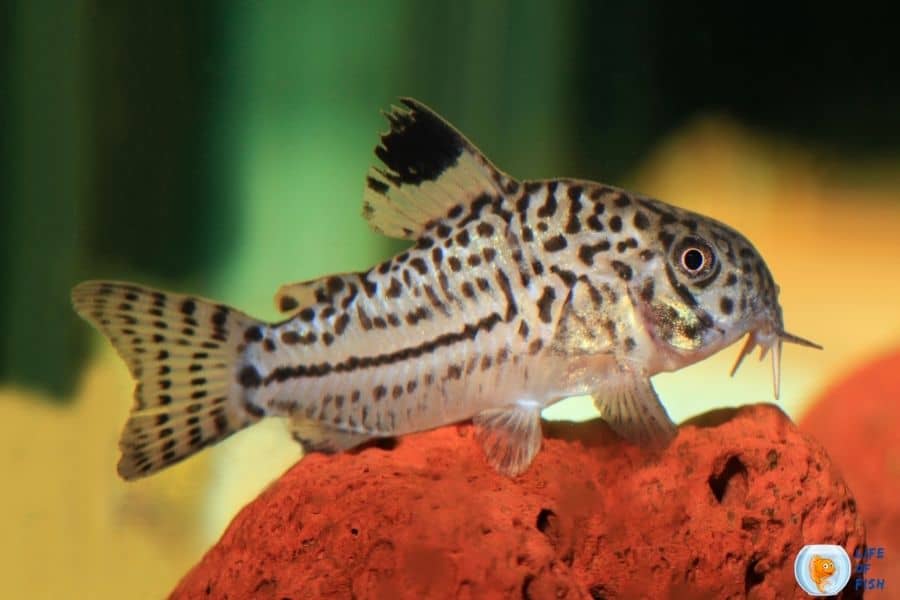
Drawbacks of lava rocks in an aquarium
There are some drawbacks to using lava rock as part of the hardscape in your tank-
The sharp and abrasive surface
Lava rocks often have sharp and abrasive surfaces which might hurt your fish.
Especially fast-moving fish and long-finned fish are at risk of getting injured by these sharp edges of lava rocks.
Trap unwanted amounts of debris
Since lava rocks are porous, they tend to trap fish waste, leftover food, and other waste and hold them.
If somehow, the rock does not already have beneficial bacteria around them, this debris can be a problem for the aquarium’s living.
The trapped debris may release harmful nutrients like Ammonia, Nitrite, and Nitrate, which can be deadly for your fish.
Can scratch or break the glass while installing
If you are not careful while installing lava rocks into your aquarium, the porous surface of these rocks may cause the glass to scratch or crack.
Therefore, cautious installation is a must to protect the glass from getting damaged or broken.
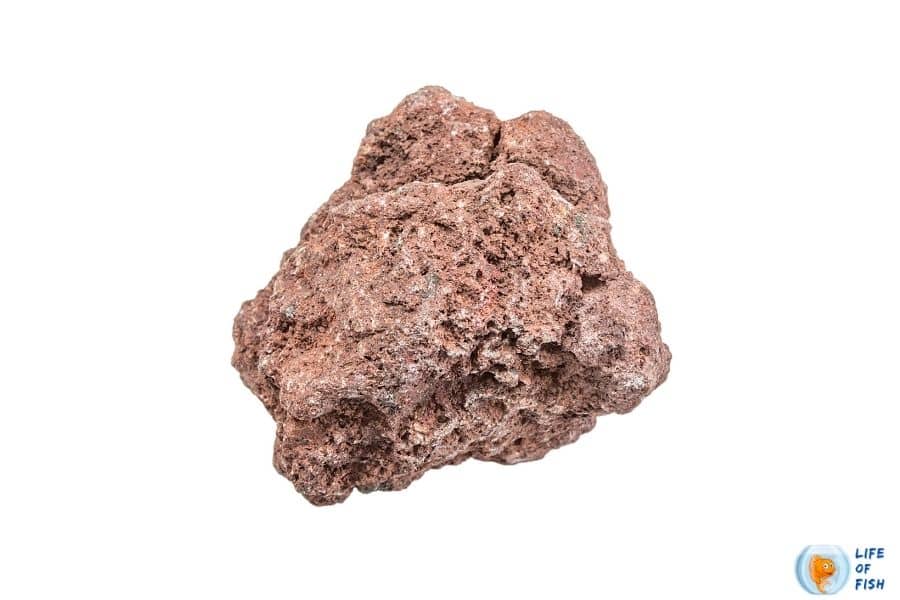
How to prepare lava rocks for an aquarium
Putting lava rocks into an aquarium is not as easy as placing some gravel into the aquarium.
There is a procedure to follow to get your lava rocks ready, making them a perfect addition to your aquarium.
Step 1- Wash Lava Rocks
The first step before you add lava rocks to an aquarium is to wash the rocks thoroughly. You can put them into a 5-gallon bucket and fill it up with water.
Let the rocks soak in the water for half an hour, then take them out and shake them a bit to remove any loose debris.
Repeat this step until you have rinsed off all the dust and dirt from the rocks.
Then follow steps 2.1, 2.2, or 2.3 to disinfect lava rocks.
Step 2.1- Boil Lava Rocks
After removing dirt by rinsing them, the next best step is to boil them. Boiling is the most effective and the safest way to disinfect rocks to be used in aquariums.
Boil water in a large container and put the rocks inside it. Let them boil for about 10 minutes, then switch off the stove and sit for another 10 minutes.
Take them out of the pot into a strainer, let all excess water drop off, and leave the lava rocks there until they are completely dry before putting them in the aquarium.
When boiling lava rocks, you shouldn’t boil them for longer than 30 minutes as overheating may cause the rocks to crumble or break.
Step 2.2- Using UV Sterilizer
If you are looking for something effective yet easy, the next possible choice is to use a UV sterilizer with your lava rocks.
Put the sterilized water into the aquarium and add lava rocks. This method will ensure that no harmful bacteria or other microorganisms are there with your rocks.
Step 2.3- Bleach the lava rocks
While bleaching is not effective as boiling, you can use this method if you think your lava rocks will crumble or break when boiled.
The best way to bleach your lava rocks is by leaving them in a 1:10 bleaching solution for 24 hours.
Afterward, don’t put the rock directly into an aquarium because it may still have some bleach on it.
Therefore, you should rinse the rocks thoroughly before adding them back inside the fish tank.
Step 3- Let Lava Rocks soak in water for five days
Once your lava rocks are clean, put them inside a container big enough so that they can fit inside without being crushed.
Fill the container with filtered water so that the rocks are almost covered in water.
Let your lava rocks soak inside this container for five days to start housing beneficial bacteria on them.
This will help reduce ammonia, nitrite, and nitrate levels in your aquarium when they are added.
You will notice some cloudy white substance forming around the rocks’ surface- this is the beneficial bacteria.
Step 4- Put Lava Rocks into your Aquarium
Once you let them soak in water for five days, place the rocks inside your aquarium carefully.
Be careful while putting them in so that you do not drop or break your tank’s glass.
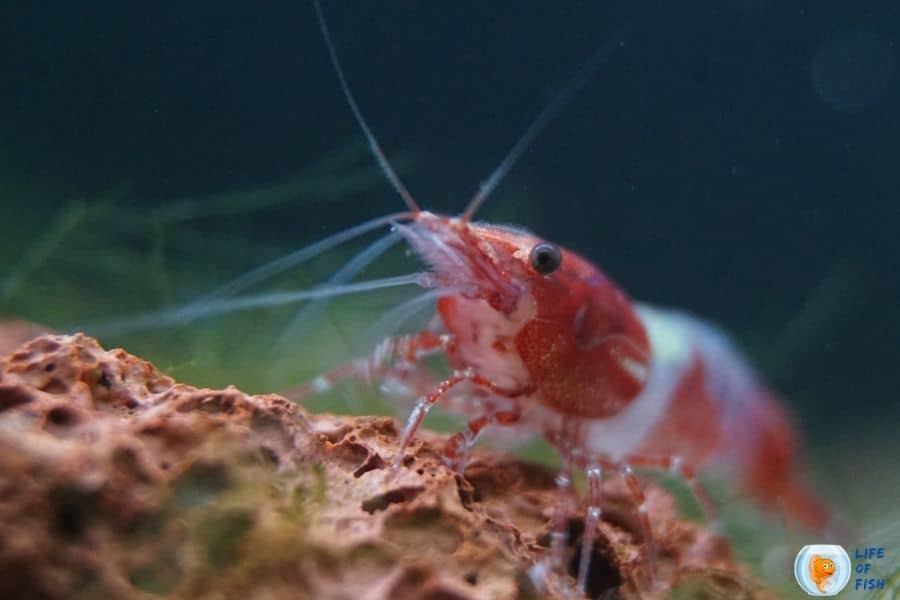
How do you add lava rocks to an aquarium safely?
When adding aquarium lava rock to your tank, one important thing to consider is that the rocks should be distributed on a flat surface.
This way, the weight of rocks will divide in the tank equally, which will cause the least stress on the tank’s glass and seams.
You should also avoid stacking aquarium rocks because they may damage your tank and stress its seams and joints.
Before adding lava rocks, adding a sand or gravel layer is better to save the tank glass from cracking.
Otherwise, you’ll have to add a styrofoam sheet on the glass surface before adding lava rocks.
You should carefully stuff lava rocks on the sides of the glass to minimize damages to the aquarium.
Where can I purchase lava rocks?
You can easily buy lava rock from any local pet store or aquarium supply store.
The best part about these kinds of stores is that they often give out free samples to try before buying, so take advantage of this and fulfill your curiosity.
When you are at the store, make sure to ask your supplier about what kind of rock it is and if any precautions come along with it.
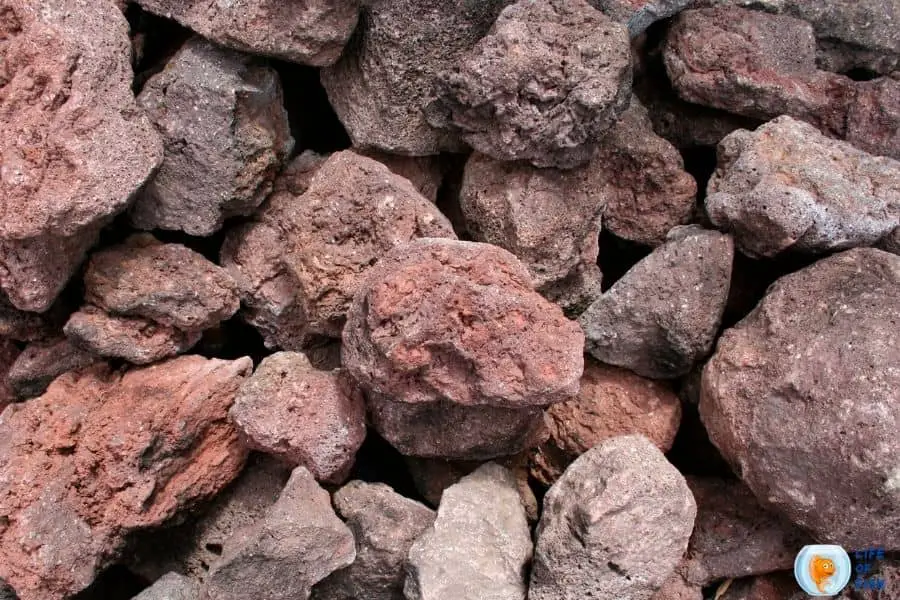
Related Questions
Will lava rock raise pH?
Lava rocks are completely inert, so they do not affect the pH levels of your water.
However, if you are using calcium carbonate rocks, which tend to lower water pH levels, it may cause problems for some aquarium inhabitants.
What rocks are bad for aquariums?
You should avoid rocks that have higher amounts of calcium and sharp-edged rocks in aquariums.
Calcium-rich rocks tend to lower the pH levels of water which may harm your fish.
And also, sharp-edged rocks can injure your fish which may cause bacterial infections afterward. Some rock types to avoid are,
- Shells or crushed coral (especially in freshwater tanks because they can lower pH and increase calcium hardness in the water)
- Limestone
- Marble
- Dolomite
- Geodes
Wrapping Up
Many people who have started using lava rocks in their aquariums have fallen in love with this decorating material because of its natural look.
Further, It does not release toxins into the water as other rocks may.
The best thing about using aquarium rocks is that they will add hiding places for your fish and provide them with extra cover that looks amazing and feels great to the touch.
Putting lava rocks into an aquarium is not as easy and quick as you might imagine.
There are some essential steps to follow in order to get your rocks ready for addition to your tank.
A lot of people just dump them into the fish tank without following proper procedures. This will cause the tank to break or crack or even kill fish with poisonous substances.
Following the steps mentioned above will make sure you are ready to put your lava rocks into an aquarium safely.
Read More: Nerite Snail Poop | 18 infamous Facts You Never Knew|
